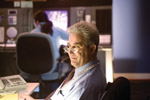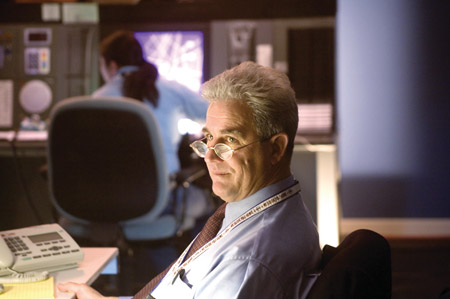United 93
 Where does one begin to comment on a film like this without injecting one’s self and one’s ego into the words being written? That is, after all, the style of “United 93.” There’s no trace of artifice, intention, agenda, style, or plot in the film. The tension that builds relies heavily on what we already know, so there’s no manufactured twist needed here. Our anxieties are…
Where does one begin to comment on a film like this without injecting one’s self and one’s ego into the words being written? That is, after all, the style of “United 93.” There’s no trace of artifice, intention, agenda, style, or plot in the film. The tension that builds relies heavily on what we already know, so there’s no manufactured twist needed here. Our anxieties are…

from writer/director/producer Paul Greengrass. Photo Credit: Jonathan Olley
Where does one begin to comment on a film like this without injecting one’s self and one’s ego into the words being written? That is, after all, the style of “United 93.” There’s no trace of artifice, intention, agenda, style, or plot in the film. The tension that builds relies heavily on what we already know, so there’s no manufactured twist needed here. Our anxieties are fueled by waiting for the inevitable outcome: On September 11, 2001, United 93 went down over rural Pennsylvania and all aboard were killed.
Do I think that it’s too soon for a film that confronts that reality? No, I don’t feel that it’s ever too soon to address any subject in an honest and straightforward manner. I think what hurts America more than talking about it is not talking about it. We’re way past emotionally-heightened reactionary measures. We learned 65 years ago, on December 7, 1941, the cold, hard fact that America is not an impenetrable fortress isolated from the rest of the world’s suffering.
After a brief introduction to the terrorists preparing for their mission, the film places us at Newark International Airport. Pilots banter, passengers wait, and our anxiety already grows. Much of the film works on this uncertainty. We know the events from the perspective of an outside observer, but for the duration of this film we’re forced to “hurry up and wait” as data comes in, facts are gathered, and events unfold.
The FAA Operations Manager Ben Sliney is being briefed on the day’s outlook. Air traffic for the day is already expected to be a tangle across the country with a high number of scheduled flights. Sliney, it should be mentioned, plays himself in the film. The Internet Movie Database (IMDb) notes that a number of the actors in the film were actual military personnel.
Cutting back and forth between the passengers boarding United 93, the FAA control center, regional Air Traffic Control and NORAD, one is given an acute sense of the immense disconnect between these various components of our nation’s disaster response.
Slowly, ATC and NORAD become aware of a situation building. ATC has lost contact with American Airlines flight 11. Eventually, a radio message is caught that sounds unlike a pilot speaking, and ATC and NORAD conclude that there’s a hijack in progress. Everyone seems taken aback as such an incident hasn’t occured in U.S. airspace in quite some time.
By this time, United Airlines flight 93 is stuck in a 30-minute delay departing Newark. As tension continues to build while waiting for the doomed flight to take off, a conspiracy becomes apparent to the alarm of everyone when the earlier radio message is transcribed to read, “We have some planes.” Remember, so far the FAA, NORAD and ATC are only aware of one hijacked plane. Soon, they will discover several. But, perhaps forgotten in the media melee since, which flights were hijacked and heading to what destinations remained a point of confusion for several hours as information and resources were being corralled, which is to say it was like herding cats.
From there, chaos begins to unravel, communication between the various federal agencies starts to break down as multiple hijackings are discovered. Trying to track them all, much less intercepting them, seems nearly impossible. There are repeated requests from the FAA for assistance from the military, but only the President can authorize an armed intercept. We’re used to watching fictional films where someone at the FAA calls the Pentagon, who notifies the President, who then orders the strike, all within two minutes. In reality, however, the gears of government turn very slowly.
The astonishing thing is that the film doesn’t criticize the government, nor does it judge the terrorists or the passengers. The film merely presents an interpretation of the facts. I say “an interpretation” because, at the time it was filmed, more was yet to be known about the details of flight 93. However, it’s a respectable extrapolation that doesn’t paint the terrorists as villains or the passengers as heroes. The movie doesn’t need to.
Consider the panic that resonates through the cabin of flight 93 as the passengers slowly become aware of the evolving plot, making calls to loved ones on air phones as they discover that the terrorists have no interest in ransom or negotiations. The World Trade Center towers have been hit. The passengers know they are going to die. This revelation is, in ways, more horrifying than the fatal events that follow. How must it feel to discover before the fact that you are trapped in a fuselage, moving toward certain death?
Some interesting observations are brought up during the course of the events. There was some discussion amongst officers at NORAD to ram the planes, because the fighters dispatched to intercept were not armed. Also, Air Force One departed Florida, leaving no one aware of their intended destination. These are a couple of the only instances where the plot connects with news we may have heard on that day.
The film’s compartmentalized storytelling also filters out premature bias of the viewer’s attitudes. A good example is the group of terrorists. They appear to be four young men indoctrinated into a fanatical cause before they had any capacity to rationally think about the actions to which they’ve committed themselves. There, in that moment, we aren’t presented with the media aftermath and public resentment of Islam. We only see four extremists, and are presented with only the opportunity to judge their choices and no one else’s.
Similarly, when we see the passengers plan and attempt to overtake the flight, the pilots of which they’ve learned have been killed, we understand their course of action—quick though carefully thought out and balanced against the alternatives at hand—is not a knee-jerk reaction but a calculated risk taken to put down the efforts of four individuals in an imminent plot to harm other individuals. That’s it. No appeals to nationalistic pride. No swelling, bombastic musical cues to artificially heighten the impact of the imagery. We see people who know they are going to die but are aware that their choices can prevent larger-scale tragedy, and we respect them.
 United 93 • Dolby® Digital surround sound in select theatres • Aspect ratio: 2.35:1 • Running Time: 111 minutes • MPAA Rating: R for language, and some intense sequences of terror and violence. • Distributed by Universal Studios
United 93 • Dolby® Digital surround sound in select theatres • Aspect ratio: 2.35:1 • Running Time: 111 minutes • MPAA Rating: R for language, and some intense sequences of terror and violence. • Distributed by Universal Studios